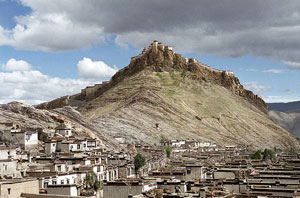|
|
Gyantse, Tibet |
|
Information about Gyantse
Gyantse or Gyangtse is the fourth largest city in Tibet
after Lhasa, Sigatse and Chamdo. It is situated in
Gyangze County and is 254 kms southwest of Lhasa. It is
located at an altitude of 3,977 metres above sea level.
Gyantse is in the fertile plain of the Nyang Chu valley
on the Friendship Highway, which connects Kathmandu,
Nepal to Lhasa, Tibet. It is strategically located on
the ancient trade routes from the Chumbi Valley, Yatung
and Sikkim, which met here. The town still has the feel
of a |
 |
|
|
frontier
town, with horses and yaks on the main streets.
History of
Gyantse
Gyantse is often referred to as the "Hero City". It was a
place of a major battle between Tibetans and British troops.
During the expedition of British Colonel Younghusband in 1904,
the 500 soldiers of the Gyantse fort resisted in a siege of
several weeks, before they were overcome by the superior
equipment of the British. The town still has the feel of a
frontier town, with horses and yaks on the main streets. It
was nearly destroyed in 1954 and was largely emptied of people
by the Chinese in 1959.
Tourist Attractions in Gyantse
The main places of interest in Gyantse are Kumbum Stupa and
Palkhor Monastery. The Kumbum stupa is only Nepalese-style
stupa in Tibet and was an important centre of the Sakya school
of Tibetan Buddhism. It is situated in the Palkhor Monastery
which is one of its kind in Tibet.
The Palkhor Monastery
The Palkhor Monastery also called Palcho Monastery it is quite
different from other monasteries of Tibet. Structured as a
typical Tibetan Buddhism monastery it was built in 1418 and
has remarkably remained intact and unscathed to this day. It
lies about 230 kilometers south of Lhasa and 100 kms east of
Shigatse at the foot of Dzong Hill. The most remarkable
feature of this monastery is that it is the only monastery
that houses monks from different orders. The monks from the
Gelugpa, Sakyapa and Kahdampa orders stay in this monastery
with noticeable harmony. Although they once quarreled and
fought, the different orders eventually discovered a way to
get along with each other. As a result, its oblation,
architecture style, deities enshrined and murals are very
special. The Main Assembly Hall of Palkhor Monastery,
Tshomchen, was built between the end of the 14th century and
the beginning of the 15th century. It is a three-storey
structure. The ground floor has a chanting hall with 48
columns that are ornamented with old silk "thangkas". It also
houses an eight- meter high bronze statue of Maitreya Buddha,
which is gilded and made from 1.4 tons of bronze. On the
second floor of monastery there are chapels belonging to
“Bodhisattva Manjushri" and "Arhats" from the Ming dynasty.
Among these the Arahat chapel is quiet popular throughout
Tibet. The roof of monastery also holds chapels which preserve
a collection of 15 "mandala" murals. These are three meters
(ten feet) in diameter. There are also some other attractive
features in monastery like the collection of about 100 robes
and costumes worn in Tibetan opera. These costumes were made
of silk, embroidery and tapestry and belong to the era of Ming
dynasty and the Qing dynasty. The Palkhor Monastery is also
popular for its tower, Palkhor Tower, also called the Ten
Thousand Buddha Tower. It is the calling card of Palkhor
Monastery and the most important building in this monastery.
The tower houses about 100 family halls for worshipping
Buddha, one over the other. It has 10,000 figures of Buddha in
the Buddhist shrines, murals and family halls which provides
it the name the Ten Thousand Buddha Tower. Another significant
feature of Palkhor Monastery is "Kumbum Stupa" which is
considered the symbol of the monastery. This pagoda style
stupa consists of hundreds of chapels in layers and houses
about a hundred thousand images of various Buddhist icons. In
total, there are about 3,000 statues, so it is called "Myriad
Buddha Stupa" also. It was an important centre of the Sakya
school of Tibetan Buddhism and still considered as one of the
most outstanding and sacred places of Tibet. This graceful
structure is one of the most visited places in Tibet.
More... |
|
|
|
Kumbum Stupa
Kumbum Stupa is one of the most distinctive temples in
the world. It is an unusual architectural masterpiece
with its nine levels rise in the manner of a step
pyramid. Its construction started in 1418 and it was
completed in 1427. It is designed in classic stupa or
pagoda style. This amazing structure is 35 meters in
height, octagonal in shape, has a 9 storey terraced
exterior, 108 chapels, and superb murals (wall
paintings). It raises over four symmetrical floors plus
two upper floors and is capped with a gold dome. The
four floors contain 108 chapels which the pilgrims visit
|
 |
|
|
from bottom
to top in a clockwise fashion. This visit ends in a group of
four chapels at the top of the temple. These chapels are
dedicated to various Buddhist deities. The word Kumbum
literally means 10,000 images and according to its name Kumbum
stupa contains 10,000 murals some of which are dates back to
15 century and still in tact. These murals form a 3D hierarchy
covering the entire spiritual path including all the tantras.
These images include Buddhas, Bodhisattvas, Vajras, Dharma
Kings, Arhats, Disciples, great adepts of different orders in
Tibetan Buddhist history, and outstanding figures in Tibetan
history such as Songtsen Gampo and Trisong Detsen. It was an
important centre of the Sakya school of Tibetan Buddhism and
still considered as one of the most outstanding and sacred
places of Tibet. |
|